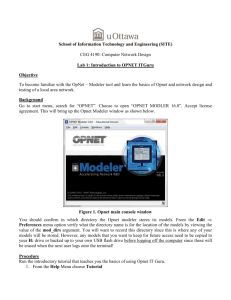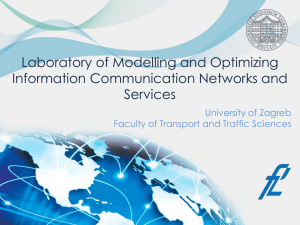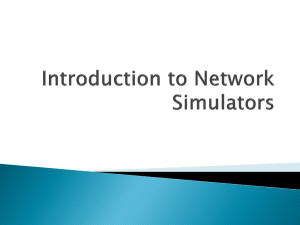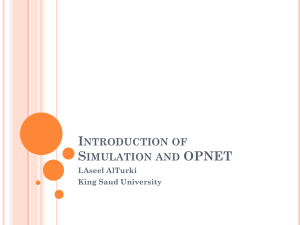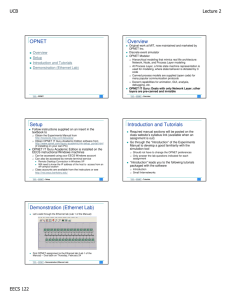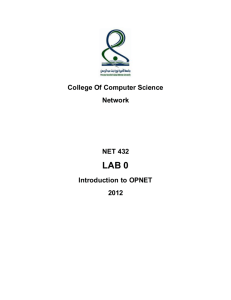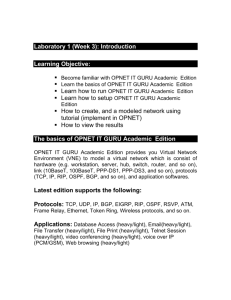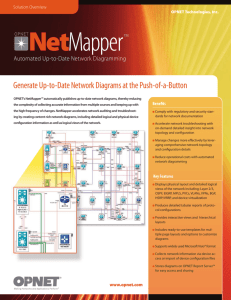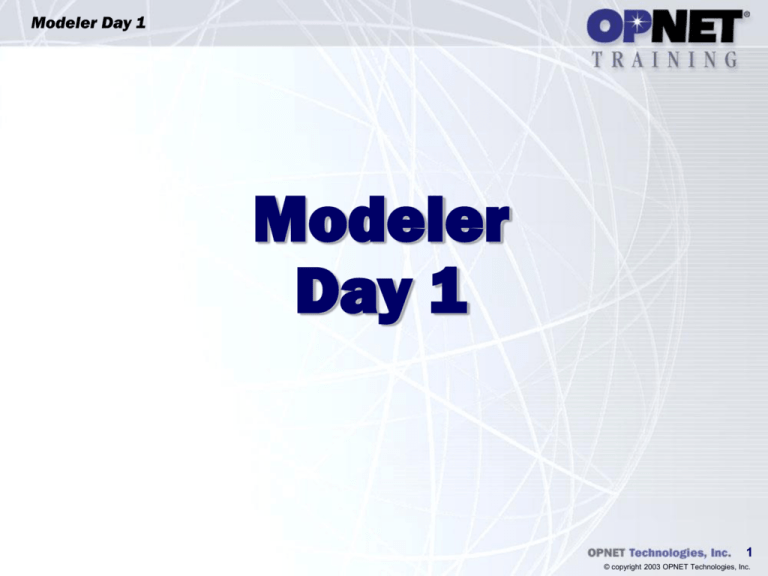
Modeler Day 1
Modeler
Day 1
1
© copyright 2003 OPNET Technologies, Inc.
Modeler Day 1
Course Content
DAY 1:
DAY 2:
• Introduction
• General Simulation Methodology
• OPNET Technologies
• Events and Event List Concepts
• History of OPNET
• Node Modeling
• OPNET Services and Support
• Node Modeling {LAB}
• Practical applications of Modeler
• Features of the Project Editor {LAB}
• Building a First Network {LAB}
• Modeling Framework
• Process Modeling
• Process Modeling {LAB}
• Collecting Scalar Statistics
• Scalar Statistics {LAB}
• Other Editors {Mini-labs}
2
© copyright 2003 OPNET Technologies, Inc.
Modeler Day 1
Course Content
DAY 3:
DAY 4:
• Configuring Standard Applications {LABs}
• Traffic Modeling Techniques {LABs}
• Modeling Large Networks
• Process Modeling Methodology
• Accelerating Wireless Simulations{LABs}
• Custom Wireless Effect {LABs}
• Importing Topology and Traffic
• Debugging Simulation Models{LABs}
3
© copyright 2003 OPNET Technologies, Inc.
Modeler Day 1
Introduction
4
© copyright 2003 OPNET Technologies, Inc.
Modeler Day 1
What is Modeler?
• An environment for building protocols and device models.
• An environment to plan changes by illustrating how the networked
environment will perform.
• An environment that includes hundreds of pre-built models, used to
study performance changes of your network: organizational scaling,
technology changes, and application deployment.
5
© copyright 2003 OPNET Technologies, Inc.
Modeler Day 1
Questions and Goals
• Questions to be answered in the OPNET Modeler Class
• What does Modeler do?
• How can it help me?
• How easy is it to use?
• How can I get started?
• Goals
• Learn what problems can be solved with Modeler
• Learn how to use the Modeler software in a hands-on environment
• Use Modeler to solve real problems
6
© copyright 2003 OPNET Technologies, Inc.
Modeler Day 1
Expectations
• Prerequisites:
• Ability to program in C or C++ or at least be comfortable in
reading/understanding C or C++ code
• Basic understanding of networks
• This class will move quickly
• Ask questions. It will enhance your learning experience, as well as
the other students.
7
© copyright 2003 OPNET Technologies, Inc.
Modeler Day 1
Format
• Purpose of the class: To give students a hands-on learning
experience and introduce many of the features of Modeler.
• About half lecture, half lab
• More lecture at the beginning – this will lay a strong foundation
• Lecture is interactive – do not hesitate to ask questions
• Labs not completed in class may be completed on your own
• Note: In the interest of time, some labs contain unrealistically
short simulation runs. Since the data may not have a chance to
converge, your results may not match the results in the manual
exactly.
8
© copyright 2003 OPNET Technologies, Inc.
Modeler Day 1
Format
• During labs, raise your hand and an assistant will help you.
• Concepts will be taught during lecture, and you will apply them
to labs. We encourage you to ask questions.
• Please provide constructive feedback for improvements to the
OPNET software, user interface, documentation, and training
session.
9
© copyright 2003 OPNET Technologies, Inc.
Modeler Day 1
OPNET Technologies
Founded in 1986
Publicly Traded (NASDAQ: OPNT)
2500+ Customer Organizations
Intelligent Network Management
Solutions
•
•
•
•
The SuperQuest Award
Enterprises
For Best E-Business Solution
Service Providers
At Supercomm
Network Equipment Manufacturers
Government
Offices in
•
•
•
•
•
•
•
•
•
Bethesda, MD (Headquarters)
Santa Clara, CA
Boston, MA
Dallas, TX
Cary, NC
Paris, France
Reading, UK
Sydney, Australia
Ghent, Belgium
In Recognition of
Visionary use of
Information Technology
10
© copyright 2003 OPNET Technologies, Inc.
Modeler Day 1
Blue Chip Customers
Manufacturers
3Com Corporation
Mitsubishi Electric
Advanced Micro Devices Motorola
Alcatel
NEC
Altamar
Nokia
Ascom
Nortel
Avaya
Onex
Boeing
Panasonic Tech.
CableLabs
Philips
Cisco Systems
Qualcomm
Cingular Wireless
Raytheon
Conexant Systems
Sharp Labs
Ensemble Commns
Siemens
Ericsson
Sony
Fujitsu
Sun Microsystems
Harris
Telcordia
Hewlett Packard
Telia
Honeywell
Tellabs
Hughes
Tellium
Intel
Terawave
ITT
Texas Instruments
Lockheed Martin
Thomson
Lucent Technologies
Toshiba
Marconi
Tropic Networks
Matsushita
TRW
MITEL
Vitesse SemiConductor
WirelessHome
Enterprises
Abbott Laboratories
ABN AMRO
Accenture
Aerospatiale
ATOFINA Petrochemicals
American Water Works
Aramco
Ashland Inc.
Avery Dennison
Bank of Oklahoma
Baptist Healthcare
BB&T
BEA Systems
Becton Dickinson
Blue Cross Blue Shield
Booz Allen & Hamilton
CACI Federal
Cal Fed
Capital One
Charles Schwab & Co.
Citicorp
Compaq Global Services
CP Ships
CSC
CSX Technology
Cummins Engine Co.
CVS Pharmacy
DaimlerChrysler
Dell Computers
DHL
DIRECTV
Entergy
Enterprise Rent-a-Car
Ernst & Young
FleetBoston Financial
First American
First Citizen
First Union National Bank
General Dynamics
IBM Global Services
Ingram Micro
Intermedia Communications
Kemper Insurance
Mary Kay
Microsoft
National Semiconductor
NCR
Newport News Shipbuilding
Northern Trust Company
Oracle
Pacificare
Peoplesoft
Petro-Canada
Predictive Systems
Prudential
QuikTrip
RadioShack
RR Donnelley
Safeway
Schneider Electric
Sears
Seattle Times
Seagate Technology
Schlumberger
Southern California Edison
Spiegel
State Street
Sun Life Assurance
Suntrust Bank
Target
Thomson Financial
Trans Canada Pipelines
TXU
Unisys
Visa International
Vision Service Plan
Wal-Mart
Waste Management
Service Providers
Allegiance Telecom
AT&T
AT&T Wireless
Belgacom
BellSouth
British Telecom
Cable & Wireless
Chunghwa Telecom
Compuserve
Deutsche Telekom
Dolphin Telecom
France Telecom
Hungarian Telecom
Hutchison 3G
Italtel S.p.A.
Indonesia Telecom
Infonet
Inmarsat
Intelsat
KDDI
Korea Telecom
LG TeleCom
Network Access Slns
Nextel
NTT DoCoMo
NTT Group
Omnitel
Orange PCS
Orbital Sciences
Polish Telecom
PT Comunicacoes
Rogers Communications
Qwest
SBC
SK Telecom
Sprint
SWIFT
Swisscom
T-Mobile
Telekom Austria
Telecom Italia
Telecom Italia Mobile
Teledesic
Telefonica
Telenor
TELUS
Telstra
TenFold
UUNET
Verizon
Vodafone
Williams
Wind Telecomm. S.p.a.
WorldCom
11
© copyright 2003 OPNET Technologies, Inc.
Modeler Day 1
Federal Customers
DoD
Army Research
Laboratories (ARL)
DARPA
Defense Information
Systems Agency (DISA)
Joint Staff (J6)
National Communication
System
National Ground
Intelligence Center
National Guard
National Image Mapping
Agency (NIMA)
National Security Agency
NATO
Naval Information
Warfare Center
Naval Postgraduate School
Naval Research
Laboratories (NRL)
Naval Surface
Warfare Center (NSWC)
Naval Underwater
Warfare Center (NUSC)
Civilian
NRaD/NCCOSC
SPAWAR East and West
Tri-Service Information
Management Program
Office (TIMPO)
US Army CECOM
US Army Combined
Arms Center
US Army HQDA/DISC4
US Army Missile
Command
US Army Signal Center
US Army Signal
Command
US Marine Corps
US Military Academy
US Air Force AFSOC
US Air Force SSG
US Air Force ESC
US Air Force AFCA
US Air Force HQ 38th EIW
US Air Force Information
Warfare Center
US Air Force PAC
US Air Force RADC
Argonne National
NASA- Ames
Laboratory
Research Center
Bureau of Alcohol Tobacco NASA- Goddard Space
& Firearms
Flight Center
Coast Guard
NASA- Glenn Research
CIA
Center
Department of Agriculture NASA- Marshall Space
Department of Commerce Flight Center
Department of State
Oak Ridge National Labs
FAA
Sandia National Labs
FBI
Social Security Admin
Federal Railroad
Tennessee Valley
Administration
Authority
Federal Reserve Bank
US Agency for
General Services Admin
International Development
IRS
US Courts
Idaho National
US Census Bureau
Engineering &
US Senate
Environmental Lab
Veterans Administration
Jet Propulsion
Laboratory
Lawrence Livermore
National Laboratory
Contractors/Partners
Aerospace Corporation
ARINC
BAE Systems
Bearing Point
Booz Allen Hamilton
BBN
Boeing
Computer Sciences
Corp.
Concurrent
Technologies Corp.
CACI Federal Systems
CISCO Federal
Cubic Defense Systems
Draper Labs
DynCorp
Eagan, McAllister
Associates
Eagle Alliance
Frontier Technology
GEC Marconi
General Dynamics
GTE
Georga Tech Research
Institute
Harris
Honeywell
Hughes
IBM Global Services
IITRI
ITT
Jaycor
JHU APL
Lockheed Martin
L-3 Communications
MIT Lincoln Labs
MITRE
Northrop Grumman
Orincon Sygenex
Optimization
Technology, Inc.
PEC Solutions
Raytheon
Rockwell Collins
SAIC
SeiCorp
Sparta
Scientific Research
Corporate
SRI International
Syracuse Research
Corporation
Systems Planning and
Analysis, Inc
Titan Lincom/BTG
Trident Systems
TRW
Veridian
XPRT Solutions
12
OPNET Confidential – Not for release to third parties
copyright
2003ofOPNET
Inc.
© 2001 OPNET Technologies, Inc. All rights reserved. OPNET and OPNET product names©are
trademarks
OPNET Technologies,
Technologies, Inc.
Modeler Day 1
Products Address Distinct Markets
Enterprises
Intelligent Network Management
for Enterprises
Service Providers
Intelligent Network
Management
for Service Providers
Manufacturers
Accelerating Network
R&D
13
© copyright 2003 OPNET Technologies, Inc.
Modeler Day 1
Products Address Total Product Life Cycle
Design
•Protocols
•Equipment
•Networks
Delivery
•Demonstrate performance
•Reduce sales cycle
Operations
•Maximize network performance and resource utilization
•Ensure correct configurations
14
© copyright 2003 OPNET Technologies, Inc.
Modeler Day 1
Why OPNET?
Networking technology
has become too complex
for traditional analytical
methods or “rules of thumb”
to yield an accurate
understanding of
system behavior
15
© copyright 2003 OPNET Technologies, Inc.
Modeler Day 1
OPNET Modeler: Accelerating Network R&D
Provides engineering professionals
with a network technology
development environment for designing
communication protocols, equipment,
networks and applications.
16
© copyright 2003 OPNET Technologies, Inc.
Modeler Day 1
Benefits and Applications…
Benefits
Applications
Boost R&D
Productivity
Improve
Product
Quality
Reduce Time
to Market
End to End Network
Architecture Design
System Level Simulation
for Network Devices
Protocol Development
and Optimization
Network Application
Optimization and
Deployment Analysis
17
© copyright 2003 OPNET Technologies, Inc.
Modeler Day 1
End-To-End Network Architecture Design
• How many subscribers can be supported over a packet cable
infrastructure?
• What migration mechanism should be used when moving from
IPv4 to IPv6?
• How can I begin to incorporate MPLS Traffic Engineering into
my network?
18
© copyright 2003 OPNET Technologies, Inc.
Modeler Day 1
Systems Level Simulation for Network Devices
• Will a proposed packet scheduling algorithm allow us to meet
Quality of Service design requirements?
• How should device queues be sized to minimize cost while
meeting throughput specifications?
• What backplane access scheme will yield optimal system
performance?
19
© copyright 2003 OPNET Technologies, Inc.
Modeler Day 1
Protocol Development and Optimization
• How can we enhance admission control procedures to
optimize backbone performance?
• What scheduling algorithm provides the most efficient use
of 2.5G or 3G wireless resources?
• Is there a superior method for presenting technology
proposals to standards groups that provides an advantage
for group acceptance?
20
© copyright 2003 OPNET Technologies, Inc.
Modeler Day 1
Network Application Optimization
• Is my application optimized to minimize impact on
network usage?
• My application runs great on my test network, but how
will it perform when it is deployed on a network with
background traffic and existing SLAs?
• How will application deployment affect my wireless
network performance?
21
© copyright 2003 OPNET Technologies, Inc.
Modeler Day 1
OPNET Modeler Features…
• Hierarchical Network Modeling
• Object-oriented Modeling
• Finite State Machine Modeling
• Total Openness
• Highly Efficient Simulation
Engine
• Comprehensive Model Library
• Statistically generated or tracebased traffic sources
• Integrated Analysis, Animation,
and Debugging Tools
22
© copyright 2003 OPNET Technologies, Inc.
Modeler Day 1
Value-Added Extensions
• Application Characterization
Environment (ACE)
• ACE Decode Module (ADM)
• Wireless
• Terrain Modeling (TMM)
• High Level Architecture (HLA)
• Multi-Vendor Import (MVI)
• Expert Service Prediction (ESP)
• Flow Analysis (FLAN)
• NetDoctor (NetDoctor)
23
© copyright 2003 OPNET Technologies, Inc.
Modeler Day 1
Specialized Models
• IP Multicast
• Circuit-switched
• MPLS
• IPv6
• PNNI
• IS-IS
• DOCSIS
• UMTS
• SSM (Server Models)
24
© copyright 2003 OPNET Technologies, Inc.
Modeler Day 1
Case Study: End-to-End Network Design with MPLS
25
© copyright 2003 OPNET Technologies, Inc.
Modeler Day 1
Case Study: QoS Scheduling for a Gigabit Switch
26
© copyright 2003 OPNET Technologies, Inc.
Modeler Day 1
Case Study:
Designing Wireless Communication Protocols
27
© copyright 2003 OPNET Technologies, Inc.
Modeler Day 1
OPNET Products and Services
http://www.opnet.com
• Announcements
• Communicate with worldwide user group
Annual conference, OPNETWORK
Technical Support
• Available via telephone, fax, and e-mail
• 9 am to 5.30 pm, Monday through Friday (excluding holidays)
Training Services - hands-on classes
• OPNET ITGuru, Modeler
• Advanced OPNET classes
• Custom classes available
Consulting - Modeling Services
• Fixed Cost
• Time and Materials
28
© copyright 2003 OPNET Technologies, Inc.
Modeler Day 1
OPNETWORK
• OPNETWORK is the largest conference in the world on network and application
modeling and simulation--offering a dynamic range of symposiums, case studies, and
modeling sessions taught by OPNET experts.
• OPNETWORK (including course materials, models, nightly entertainment, all meals,
and online proceedings) is free to all OPNET clients and client organizations. Those
interested in attending who are not from a client organization will be considered on a
case-by-case basis.
• This year’s conference held at the Reagan
Building in Washington, D.C.
• For Current Information: www.opnet.com
29
© copyright 2003 OPNET Technologies, Inc.
Modeler Day 1
Features of the
Project Editor
30
© copyright 2003 OPNET Technologies, Inc.
Modeler Day 1
Overview
• Project Editor:
• Workflow
• More Details of the Project Workspace
• Map Backgrounds
• Zooming
• Threshold Value
• Annotation Palette
• Project Workspace {Lab}
• Models
• Deriving and Creating New Devices {Lab}
• Object Attributes
• Client-Server Configuration Example
• Statistics
• Product Documentation
31
© copyright 2003 OPNET Technologies, Inc.
Modeler Day 1
Projects and Scenarios
• Modeler uses a Project-and-Scenario approach to modeling networks.
• A Project is a collection of related network scenarios in which each
explores a different aspect of network design. All projects contain at
least one scenario.
• A Scenario is a single instance of a network. Typically, a scenario
presents a unique configuration for the network, where configuration
can refer to aspects such as topology, protocols, applications, baseline
traffic, and simulation settings.
32
© copyright 2003 OPNET Technologies, Inc.
Modeler Day 1
The Project/Scenario Workflow
• Create project
• Create baseline scenario
•
•
•
•
•
Import or create topology
Import or create traffic
Choose results and reports to be collected
Run simulation
View results
• Duplicate scenario
• Make changes
• Re-run simulation
• Compare results
Iterate
33
© copyright 2003 OPNET Technologies, Inc.
Modeler Day 1
Project Editor
• Several tools are included in Modeler to intuitively map from
network specifications to a modeled network.
Example network model:
• Use the Startup Wizard to specify the
initial environment of a scenario.
• Select objects from an Object Palette.
• Use Node and Link objects to represent
actual topology.
• Use Rapid Configuration to quickly
deploy common network topologies.
• Edit the Attributes of nodes
and links to customize their behavior.
34
© copyright 2003 OPNET Technologies, Inc.
Modeler Day 1
Map Backgrounds
• Modeler includes several maps that can be loaded as backgrounds for network
models.
• Map backgrounds provide a physical context for model specification.
• Models are more easily interpreted when set in a proper geographical context.
• Distance between nodes can be a factor in affecting simulation results.
• Maps can be imported as well as shown below.
• The format for an imported image is:
• .tiff, geotiff, MapInfo
Image of part of Chicago
35
© copyright 2003 OPNET Technologies, Inc.
Modeler Day 1
Setting Background Maps
•
Note that several maps can
overlay each other.
•
View/hide maps by
choosing View / Set
Background Properties
•
Geotiff images
automatically appear at the
correct latitude and
longitude position.
36
© copyright 2003 OPNET Technologies, Inc.
Modeler Day 1
Zoom In / Zoom Out
• Zooming in and out allows you to magnify the network in the
workspace.
• This may be for display purposes or to emphasize a particular
portion of the model.
Notice the difference
in detail.
37
© copyright 2003 OPNET Technologies, Inc.
Modeler Day 1
Zoom In / Zoom Out
• The zoom button on the project toolbar allows you to define a
rectangular area to magnify by clicking and dragging the mouse.
• The unzoom button returns the workspace to the previous
magnification level.
• Right clicking on the workspace and choosing “Zoom In” or
“Zoom Out” allows you to select a center point upon which to
zoom in or out.
• The “Zoom to Selection” feature on the same
menu allows you to zoom in on a selected
object.
• The “Zoom to Window” feature allows you
to return to the original magnification level.
38
© copyright 2003 OPNET Technologies, Inc.
Modeler Day 1
Threshold Attribute
• The threshold attribute of a node
model affects its display
characteristics at different zoom
levels.
• If the threshold value is higher than
the current resolution of the map, the
node will be displayed with a
miniaturized icon.
• This attribute ensures that large
network diagrams do not become
cluttered with icons at higher
resolution levels.
39
© copyright 2003 OPNET Technologies, Inc.
Modeler Day 1
Thresholds (cont.)
• Consider this WAN in Europe.
Map resolution: 15 pixels/degree
Object thresholds: 10
Map resolution: 80 pixels/degree
Object thresholds: 10
When we zoom out and resolution decreases,
our diagram becomes unreadable and
unwieldy.
At this resolution, we are able to discern
between the different nodes.
Note that these two pictures represent the same
network model.
40
© copyright 2003 OPNET Technologies, Inc.
Modeler Day 1
Thresholds (cont.)
•
The resolution of the map of Europe in the picture below is 15 pixels per degree. Use
trial and error to find a good appropriate threshold level. In this case, a threshold level of
40 looks good.
• Note that often it will be a case of trial and error for a user to determine a
threshold level that is suitable for a specific model.
41
© copyright 2003 OPNET Technologies, Inc.
Modeler Day 1
Annotation Palette
• Add rectangles, circles, lines and text to
models to enhance their appearance.
• This method is an effective way to
graphically illustrate and document the
changes made to a model.
• Does not affect simulations.
• Open by selecting Topology / Open
Annotation Palette.
• Annotations have attributes that configure
their appearance.
• Annotations can be hidden.
42
© copyright 2003 OPNET Technologies, Inc.
Modeler Day 1
Subnets
• A subnetwork abstracts network components specified within it
into a single object.
• Subnetworks:
• Represent identical constructs in an actual
• Have no behavioral aspects, but simplify
networks.
• May be stationary or mobile.
3 Subnet Types
network.
representation of large
43
© copyright 2003 OPNET Technologies, Inc.
Modeler Day 1
Why Use Subnets?
• Subnets are a powerful mechanism for breaking down a system’s
complexity through abstraction.
• Consider two connected Ethernet networks in San Francisco and Los
Angeles.
44
© copyright 2003 OPNET Technologies, Inc.
Modeler Day 1
Why Use Subnets?
• Subnets can be used to segment networks into distinct parts based
on proximity, connectivity, or architecture.
45
© copyright 2003 OPNET Technologies, Inc.
Modeler Day 1
Object Hierarchy
• Subnets represent various network components in a single object.
This object could contain various LAN, node, and link models.
• LANs represent a local area network abstracted into a single node.
• Nodes represent servers, workstations, switches, gateways or any
other physical devices associated with communication networks.
• Links represent the physical links between nodes.
46
© copyright 2003 OPNET Technologies, Inc.
Modeler Day 1
Locating the Right Models and Components
• Selecting the right models and components is essential to accurate
modeling.
• Modeler provides a suite of standard and vendor models.
• You can also create new models or derive models from an existing
database.
• Modeler’s naming conventions, custom palettes, icons, and derived
models all facilitate your selection of the correct components for your
network.
47
© copyright 2003 OPNET Technologies, Inc.
Modeler Day 1
Model Library
• The “Model Library” is an extensive library of standards-based and
vendor models.
• Our Modeling Dept. is responsible for design, development, and ongoing evolution of the “model library”.
• Models are created using published protocol standards and other
widely used vendor implementations.
•
•
•
•
IEEE Specifications (e.g., 802.1q, 802.3, 802.11, etc.)
ANSI Standards (e.g., X3.139, T1.513, etc.)
ATM Forum Specifications (e.g, UNI 3.1, TM 4.0, etc.)
RFC Documents (e.g., RFC-793, RFC-1058, RFC-1771, etc.)
• Vendor Technologies (e.g., VLAN tagging, EIGRP, etc.)
48
© copyright 2003 OPNET Technologies, Inc.
Modeler Day 1
Model Library Components
• The “Model Library” contains a variety of objects used for creating networks
•
Traffic generators (workstations, servers, stations, etc.)
•
Network devices (hubs, bridges, switches, routers, etc.)
•
Links (SONET, PPP, FDDI, 10BaseT, ISDN, xDSL, etc.)
•
Vendor device models (Cisco Systems, 3Com, Nortel, Lucent, HP, etc.)
• These models are ready-to-use to create networks and predict performance
behavior.
49
© copyright 2003 OPNET Technologies, Inc.
Modeler Day 1
Model Libraries available
• OPNET Model Libraries
• Standard Model Library
• Essential models that support the majority of OPNET modeling users.
• Comes with the software.
• Vendor Model Library
• Extensive library of pre-built vendor device models.
• Specialized Model Library
• Models of interest to more focused communities within the OPNET user base.
• These models correspond to emerging or vendor-specific technologies.
• They are available on a fee/license basis.
• Current specialized models.
• Circuit-switched / SS7
-Server Modeling
• IP Multicasting
-DOCSIS
• MPLS
-UMTS
• PNNI
-IPv6
50
© copyright 2003 OPNET Technologies, Inc.
Modeler Day 1
Network Objects
•
•
•
•
•
Network models consist of nodes, links and subnets.
Nodes represent network devices -- servers, workstations, routers, etc.
Links represent point-to-point and bus links.
Icons assist you in quickly locating the correct nodes and links.
Vendor models are distinguished by a specific color and logo for each
company.
Generic Devices
Vendor Devices
51
© copyright 2003 OPNET Technologies, Inc.
Modeler Day 1
Model Naming Convention
• OPNET’s standard model suite uses a specific naming convention for
its node models:
<protocoln>…<protocoln >_<function>_<modifier>
• <protocoln> is an abbreviation that specifies a particular protocol that
is supported within the model. The variable n represents the number
of protocol interfaces within that model.
• <function> is an abbreviation that indicates the general function of
the node, e.g. gateway, workstation, server.
• <modifier> indicates the level of derivation of the model.
52
© copyright 2003 OPNET Technologies, Inc.
Modeler Day 1
Model Naming Convention (cont.)
• Levels of derivation (<modifier> value)
• adv: advanced model. All node attributes are available and attribute values are
set to their defaults.
• int: intermediate model. Attributes that are unlikely to be changed are hidden and
typical values are applied to the visible attributes.
• Models with no value for modifier are derived from intermediate models.
Additional attributes are hidden and only attributes needed for parametric studies
are visible.
• Example: ethernet128_hub_adv
This model represents a hub with 128 ethernet interfaces. Since it is
an advanced model, all the model’s attributes are visible and editable.
53
© copyright 2003 OPNET Technologies, Inc.
Modeler Day 1
Model Naming Convention (cont.)
• Instructor demonstration: Show example of derived model and its
parents: ethernet16_switch (ethernet palette).
54
© copyright 2003 OPNET Technologies, Inc.
Modeler Day 1
Vendor Models
• In addition to our standard models, OPNET contains vendor specific
models.
Vendors:
3Com
Ascend
Avici
Bay Networks
Cabletron
Cisco Systems
eXtreme
Fore Systems
Foundry
Hewlett Packard
Juniper Networks
Lucent
NEC
Newbridge
Nortel
55
© copyright 2003 OPNET Technologies, Inc.
Modeler Day 1
Vendor Models (cont.)
• Naming convention for vendor models
<Vendor_Name>_<Device_Name>_<Number_of_Slots>_<Configuration>
Example:
CS_4000_3s_e6_f_fr2_sl2
This model represents a Cisco Systems 4000 Router with 3 slots, 6
ethernet ports, 1 FDDI port, 2 frame relay ports, and 2 SL-IP ports.
• View description of the node by:
• Right-clicking on the
node in the object palette.
• Right-clicking on the node
in the workspace and selecting
“View Node Description”.
56
© copyright 2003 OPNET Technologies, Inc.
Modeler Day 1
Vendor vs. Generic Device Models
• Vendor device models
• Each supported vendor has a palette
• Device icon depicts vendor product
• Related vendor objects are grouped
• Generic device models
• Provide general functionality and
protocols
• Modify attributes such as processor speed
or forwarding rate to represent devices in
your network
57
© copyright 2003 OPNET Technologies, Inc.
Modeler Day 1
Choosing Link Models
• An appropriate link must be chosen
to match interfaces on connected
devices.
• Data rate, protocol, and number of
available interfaces are the
requirements that must be met.
• Link model naming convention:
• <protocol>_<modifier>
• Example:
• 10BaseT_adv
58
© copyright 2003 OPNET Technologies, Inc.
Modeler Day 1
Utility Objects
• Perform logical functions, such as
• Configuration of global network resources (e.g., setting up PVCs)
• Scripting special simulation events (e.g., failing a device at a given time)
• Setting application traffic parameters that all network objects can use
• Only one of each is needed in model, positioning does not matter
59
© copyright 2003 OPNET Technologies, Inc.
Modeler Day 1
LAN Models
• LAN models abstract complex local area
networks that may contain multiple nodes
with the same configurations
• LAN models also
• Reduce time to build model
• Use less memory
• Reduce unnecessary clutter
• Generate fewer simulation events, allowing
simulations to run faster
These models
represent the
same network
60
© copyright 2003 OPNET Technologies, Inc.

